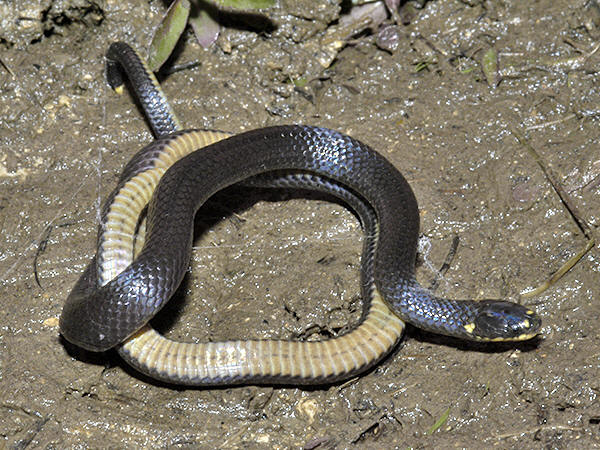
Fig 1

Fig 2

Fig 3

Fig 4
|
Family :
ELAPIDAE
Species : Toxicocalamus atratus
(part of the T. loriae species complex)
Snout-vent Length : up to 68.2 cm (females)
Maximum Size : ~ 75-80 cm total length
Toxicocalamus atratus was first described in 2022, although the type
specimen was collected back in 1964 (Kraus et al, 2022). It was formerly
considered part of
Toxicocalamus loriae.
The species is endemic to the Central Highlands of Papua New Guinea,
occurring at elevations of between 840 and 2140 metres.
This is a
secretive, diurnal, ground-dwelling snake of forests and adjacent clearings.
It lives
amongst the complex tangle of leaf litter, moss growth and rotting logs of
PNG's forest floor. In cleared areas adjacent to forest it may be
encountered more easily, for example in Kundiawa, Chimbu Province it occurs in agricultural plots ('gardens'),
typically hiding beneath piles of
vegetation.
The example illustrated here is a relatively large juvenile (total length
= 52 cm) found during the daytime; it was crossing an area of cleared land close to primary forest, at an elevation of 1760 metres
in Southern Highlands Province, PNG. It was inoffensive in
temperament, and made no attempt to bite.
Forest snakes (Loria spp.) are cylindrical in cross
section, the head is of similar diameter, albeit somewhat flattened
which allows for easy burrowing, and the eyes are small. Their diet is known to
include earthworms.
Adult
Toxicocalamus atratus are mainly black to blackish brown on both
dorsal and ventral surfaces, however juveniles have buff/yellowish venters.
Juveniles have a small yellow patch on each prefrontal scale, and an
incomplete, yellow nuchal collar; these fade in adults or may be completely
absent.
The supralabials and infralabials (i.e. the scales above and below the
mouth) are yellow in juveniles; these colours may persist into adult forms.
Fig 1 : 52 cm juvenile from the Kutubu area, Southern Highlands Province, PNG
at an elevation of 1760 metres.
Fig 2 : Side view of the head showing the yellow
supralabial and infralabial scales.
Fig 3 : Full view showing buff underside, typical of juvenile
Toxicocalamus atratus.
Fig 4 : Typical dense montane forest in Southern Highlands Province,
PNG.
Reference :
Kraus F, Kaiser H & O’Shea, M. (2022). Hidden diversity in
semi-fossorial Melanesian forest snakes: A revision of the
Toxicocalamus loriae complex (Squamata, Elapidae) from New Guinea.
Vertebrate Zoology 72 997–1034.
|